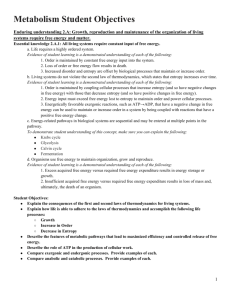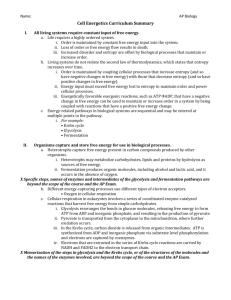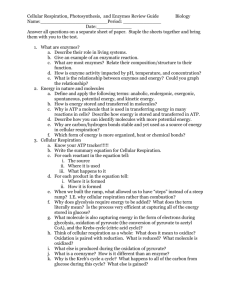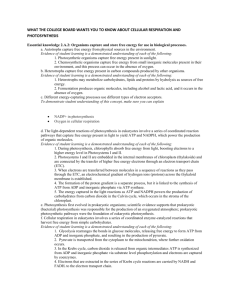File
advertisement
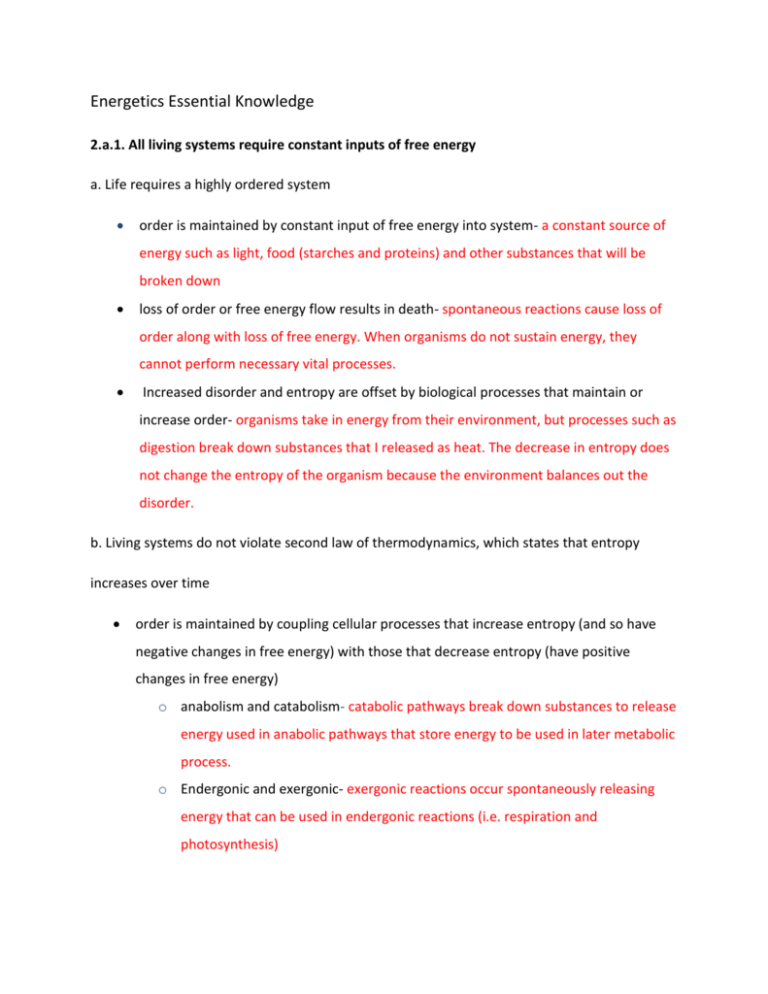
Energetics Essential Knowledge 2.a.1. All living systems require constant inputs of free energy a. Life requires a highly ordered system order is maintained by constant input of free energy into system- a constant source of energy such as light, food (starches and proteins) and other substances that will be broken down loss of order or free energy flow results in death- spontaneous reactions cause loss of order along with loss of free energy. When organisms do not sustain energy, they cannot perform necessary vital processes. Increased disorder and entropy are offset by biological processes that maintain or increase order- organisms take in energy from their environment, but processes such as digestion break down substances that I released as heat. The decrease in entropy does not change the entropy of the organism because the environment balances out the disorder. b. Living systems do not violate second law of thermodynamics, which states that entropy increases over time order is maintained by coupling cellular processes that increase entropy (and so have negative changes in free energy) with those that decrease entropy (have positive changes in free energy) o anabolism and catabolism- catabolic pathways break down substances to release energy used in anabolic pathways that store energy to be used in later metabolic process. o Endergonic and exergonic- exergonic reactions occur spontaneously releasing energy that can be used in endergonic reactions (i.e. respiration and photosynthesis) energy input must exceed free energy lost to entropy to maintain order and power cellular processes- the amount of free energy lost and gained are never equal because free energy can never reach equilibrium. If a system has minimum free energy, it cannot do work in cellular processes. Energetically- favorable exergonic reactions, such as ADP to ATP, that have a negative change in free energy can be used to maintain or increase order in a system by being coupled with reactions that have a positive free energy change- the amount of free energy required to phosphorylate ADP comes from exergonic reactions where it creates ATP. c. Energy- related pathways in biological systems are sequential and may be entered at multiple points in the pathway Krebs Cycle- carbon is taken out of glucose in several steps of this cycle Glycolysis- ATP is used to split glucose to form molecules of pyruvic acid. This begins the oxidation of glucose which produces NADH and ATP. Calvin Cycle- inorganic carbon enters the cycle where it is converted into sugar Fermentation- produces ATP by only substrate level phosphorylation. (Alcohol fermentation produces ethanol and lactic acid fermentation produces lactate) - There is a relationship between metabolic rate per unit body mass and size of multicellular organisms-generally the smaller the organism, the higher the metabolic rate2.a.2 Organisms capture and store free energy for use in biological processes. a. Autotrophs capture free energy from physical sources in the environment. Photosynthetic organisms capture free energy present in sunlight- plants capture light energy from the sun and convert into chemical energy. Chemosynthetic organisms capture free energy from small inorganic molecules present in their environment, and this process can occur in the absence of oxygen- the use inorganic substances to gain chemical energy is different than photosynthesis (uses solar energy to make organic matter) b. Heterotrophs capture free energy present in carbon compounds produced by other organisms. Fermentation produces organic molecules, including alcohol and lactic acid, and it occurs in the absence of oxygen- catabolic pathway that partially breaks up sugar and do not require oxygen c. Different energy-capturing processes use different types of electron acceptors. NADP+ in photosynthesis- in the light reaction of photosynthesis, enzymes turn NADP+ to NADPH which transfers electrons to the Calvin Cycle Oxygen in cellular respiration- oxygen is the final electron acceptor which is used with H+ ions to create water d. The light-dependent reactions of photosynthesis in eukaryotes involve a series of coordinated reaction pathways that capture free energy present in light to yield ATP and NADPH, which power the production of organic molecules. During photosynthesis, chlorophylls absorb free energy from light, boosting electrons to a higher energy level in Photosystems I and II- light absorbed in pigments of chlorophyll excite electrons, and this is the noncyclic flow of electrons that involves each excited electron pass from PSII to PSI. The fall of the electrons back to the ground state creates ATP. Photosystems I and II are embedded in the internal membranes of chloroplasts (thylakoids) and are connected by the transfer of higher free energy electrons through an electron transport chain (ETC). Electrons that are excited go from PSII to PSI through the electron acceptor chain allow the electrons to go to where electrons are needed to continue the light reactions. When electrons are transferred between molecules in a sequence of reactions as they pass through the ETC, an electrochemical gradient of hydrogen ions (protons) across the thylakoid membrane is established- Water is split into H+, oxygen and electrons through photolysis. The formation of the proton gradient is a separate process, but it is linked to the synthesis of ATP from ADP and inorganic phosphate via ATP synthase- the electron transport chain pumps proteins across the membrane and electrons are passed through electronegative carriers. ATP synthase is powered by the proton motive force. The energy captured in the light reactions as ATP and NADPH powers the production of carbohydrates from carbon dioxide in the Calvin cycle, which occurs in the stroma of the chloroplast- the light reaction produces ATP and NADPH, this is used to convert CO2 molecules to 3-carbon sugars in the stroma. f. Cellular respiration in eukaryotes involves a series of coordinated enzyme catalyzed reactions that harvest free energy from simple carbohydrates. Glycolysis rearranges the bonds in glucose molecules, releasing free energy to form ATP from ADP and inorganic phosphate, and resulting in the production of pyruvate- during glycolysis, ATP is needed to oxidize sugars Pyruvate is transported from the cytoplasm to the mitochondrion, where further oxidation occurs. Pyruvate is converted into acetyl CoA in the mitochondria and used in the Krebs cycle In the Krebs cycle, carbon dioxide is released from organic intermediates ATP is synthesized from ADP and inorganic phosphate via substrate level phosphorylation and electrons are captured by coenzymes- the sugars that enter the cycle are broken down, CO2 and ATP are released from ADP. NAD+ is changed to NADH and FADH2. Electrons that are extracted in the series of Krebs cycle reactions are carried by NADH and FADH2 to the electron transport chain- the path of electrons during cellular respiration is food, NADH, ETC, O2. NADH moves electrons from the Kreb’s cycle to respiration g. The electron transport chain captures free energy from electrons in a series of coupled reactions that establish an electrochemical gradient across membranes (chemiosmosis) Electron transport chain reactions occur in chloroplasts (photosynthesis), mitochondria (cellular respiration) and prokaryotic plasma membranes- chemiosmosis occurs in photosynthesis and respiration, the H+ comes from water in photosynthesis and glucose in respiration. Chemical energy is converted from light energy through photosynthesis and proton motive force powers ATP synthesis during respiration. In cellular respiration, electrons delivered by NADH and FADH2 are passed to a series of electron acceptors as they move toward the terminal electron acceptor, oxygen. In photosynthesis, the terminal electron acceptor is NADP+- oxygen is the final electron acceptor in respiration after the ETC. the exergonic flow through ETC causes chemiosmosis to create an H+ gradient The passage of electrons is accompanied by the formation of a proton gradient across the inner mitochondrial membrane or the thylakoid membrane of chloroplasts, with the membrane(s) separating a region of high proton concentration from a region of low proton concentration. In prokaryotes, the passage of electrons is accompanied by the outward movement of protons across the plasma membrane- Chemiosmosis powers ATP synthase in oxidative phosphorylation, H+ gradient must be maintained to create water to be used within a cell. The flow of protons back through membrane-bound ATP synthase by chemiosmosis generates ATP from ADP and inorganic phosphate- ATP synthesis is pushed back across membrane by H+ which created ATP, this energy synthesis uses oxygen (oxidative phosphorylation), it produces most of the ATP in cellular respiration. h. Free energy becomes available for metabolism by the conversion of ATP→ADP, which is coupled to many steps in metabolic pathways- ATP hydrolysis goes to ADP and the phosphate group makes energy for cellular work 4.B.1: Interactions between molecules affect their structure and function. a. change in the structure of a molecular system may result in a change of the function of the system b. the shape of enzymes, active sites and interaction with specific molecules are essential for basic functioning of the enzyme For an enzyme-mediated chemical reaction to occur, the substrate must be complementary to the surface properties of the active site. In other words, the substrate must fit into the enzyme’s active site- The substrate is the reactant that the enzyme acts on, the active site is the area that binds the substrate into an open area in the protein. A perfect fit is necessary for the substrate to enter the enzyme. Cofactors and coenzymes affect enzyme function; this interaction relates to a structural change that alters the activity rate of the enzyme. The enzyme may only become active when all the appropriate cofactors or coenzymes are present and bind to the appropriate sites on the enzyme- The fit for the substrate into the active site produces a non-protein to help with catalytic activity. They can fit together loosely or permanently. Other molecules and the environment in which the enzyme acts can enhance or inhibit enzyme activity. Molecules can bind reversibly or irreversibly to the active or allosteric sites, changing the activity of the enzyme.- Competitive enzyme inhibitors look like the normal substrate and enters the active site, to block the other substrate. Noncompetitive inhibitors bind to another part of the enzyme, causing the enzyme to change shapes, decreasing effectiveness The change in function of an enzyme can be interpreted from data regarding the concentrations of product or substrate as a function of time. These representations demonstrate the relationship between an enzyme’s activity, the disappearance of substrate, and/ or presence of a competitive inhibitor- The enzyme’s activity may be the result of an inhibitor or disappearance of an enzyme, this data can be represented by graphs.


